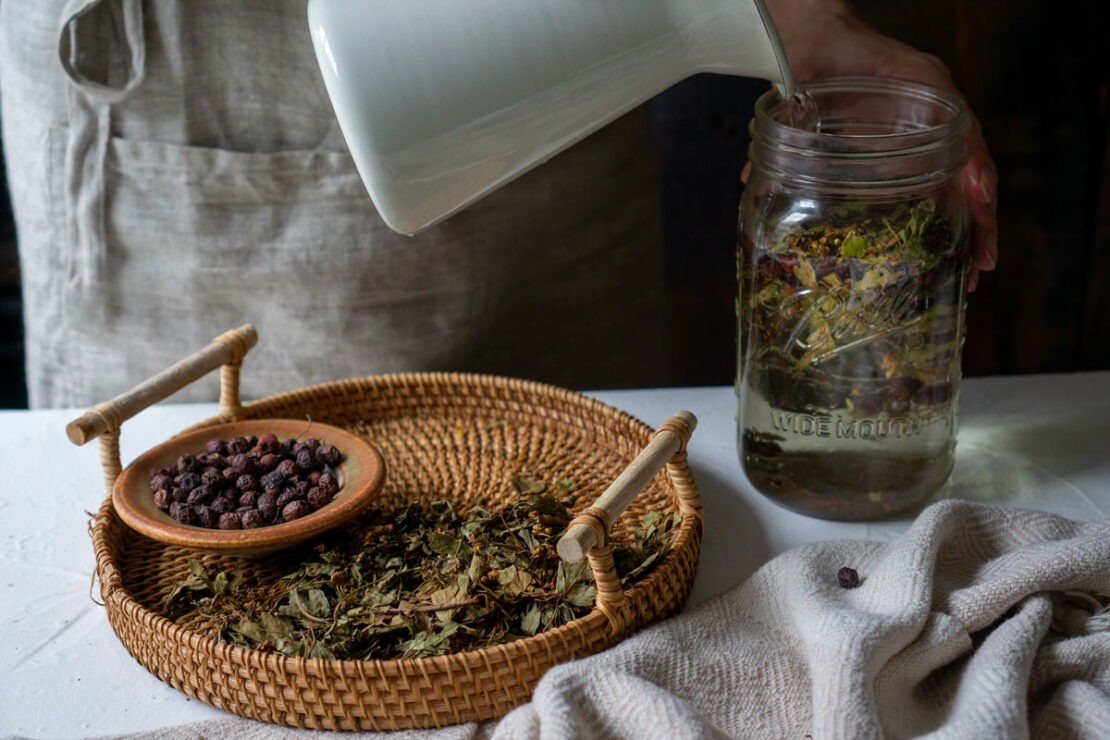
Tincture, Decoction, Tea, or Ghee: An Ayurvedic Perspective on Herbal Preparations
We all have our preferred methods of enjoying herbs. Some love hot herbal tea, some like a cool infusion, and others reach for the convenience and potency of tinctures. Or, some may crave the unctuous, nourishing qualities of herb-infused oils and ghee. There are many reasons why one may choose one type of herbal preparation over another. In Ayurveda, the optimal herbal preparation is more than a matter of simple preference or convenience. There are distinctive reasons for choosing a tincture, decoction, infusion, herbal juice, or ghee. In this post, you will become familiar with the ayurvedic perspective on different types of herbal preparations, and some reasons why you may want to choose one preparation over another.
The ideal way to take a particular herb depends somewhat on the herb itself. Some herbs make wonderful tea and others are so bitter or astringent that the most reliable way to get them down is in capsule or tablet form. Also, some herbs are better taken fresh whereas others require decoction or tincturing to extract their benefits. That said, the energetics of the individual receiving the herbs also help determine which herbal preparation is best. Let’s look, from an ayurvedic perspective, at some of the major herbal preparations in Ayurveda and the energetics of each.
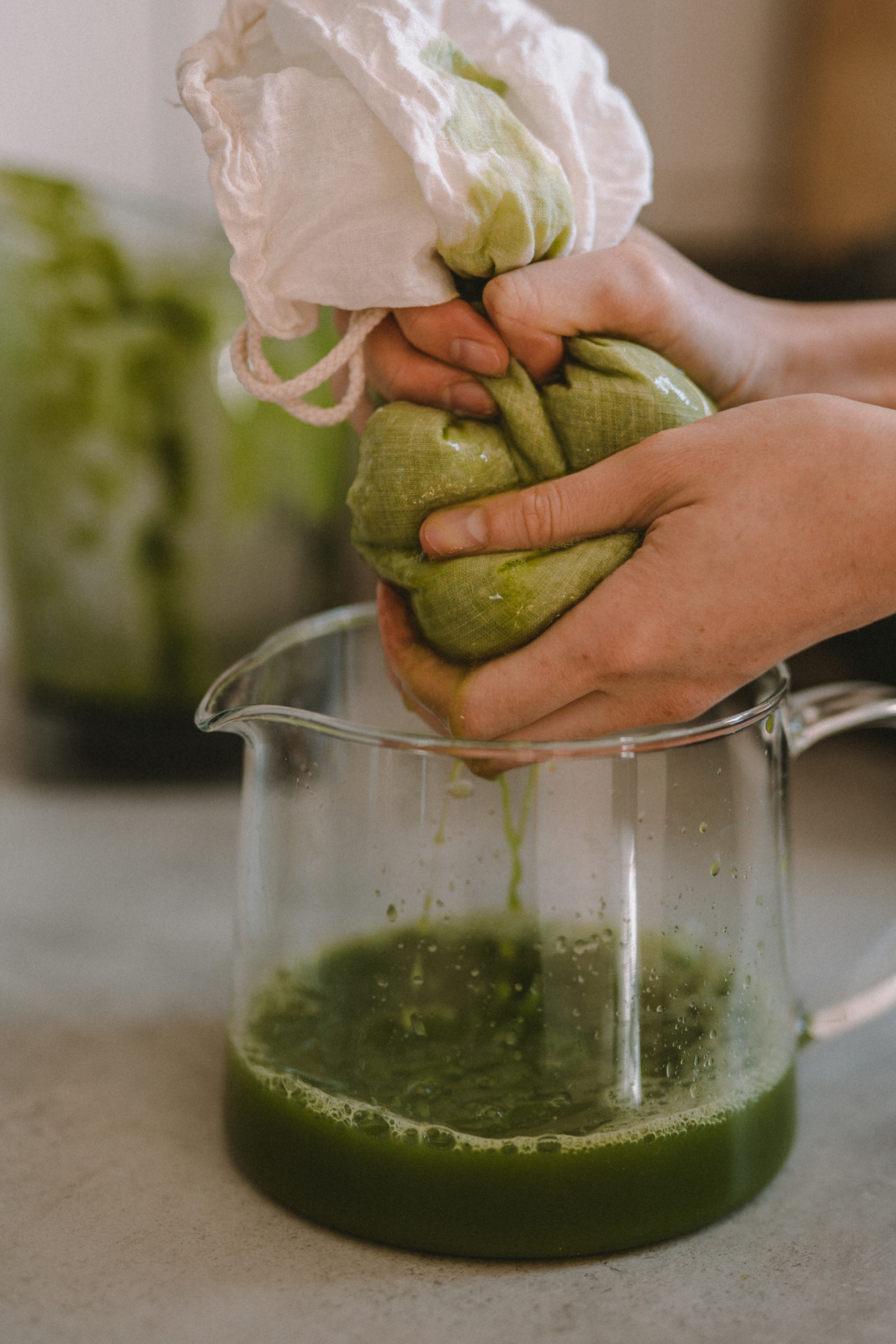
Fresh Juice Herbal Preparation
Fresh-pressed juice is a fairly popular health food these days. Just as you would drink fresh carrot or beet juice, you can also use herbs to make a fresh juice preparation. If you have a juicer at home, perhaps you have made fresh ginger juice. Some other herbs that lend themselves to juicing include cilantro (Coriandrum sativum), turmeric (Curcuma longa), aloe vera (Aloe vera), nettle (Urtica dioica), parsley (Petroselinum crispum), and though not typically considered herbs, lemon and lime (Dass, 2013). Some of these herbs require a very high volume to yield a small amount of liquid, so you can of course use them to augment a fresh fruit or vegetable juice instead of serving as a stand-alone. Also, some fresh juices, such as aloe vera, can be purchased from the store. Aloe vera and other fresh herbal juice preparations are typically not intended to be consumed in large amounts, but rather in small quantities, such as in dosages of 1 teaspoon to 4 tablespoons at a time, depending on the potency and intensity of the herb (Dass, 2013).
Depending on the herb, a fresh herbal juice may even be used topically as well as internally. For instance, cilantro leaves can be applied externally to soothe hives and rashes. To do this, blend a large handful of chopped cilantro leaves with a small amount of water and then strain and apply to the affected area and allow to dry (Dass, 2013). In Ayurveda, cilantro leaves are considered to be remarkably calming for pitta dosha and many pitta-related issues.
The energetics of fresh juice preparations largely depends upon the herbs used. In general, preparations with a cool or cold temperature pacify pitta dosha and may aggravate vata and kapha dosha. However, even cool ginger (Zingiber officinale) juice will be heating since ginger itself is so hot. Therefore, from an ayurvedic perspective, one has to look at the herbs used to understand the energetics of a particular herbal juice preparation.
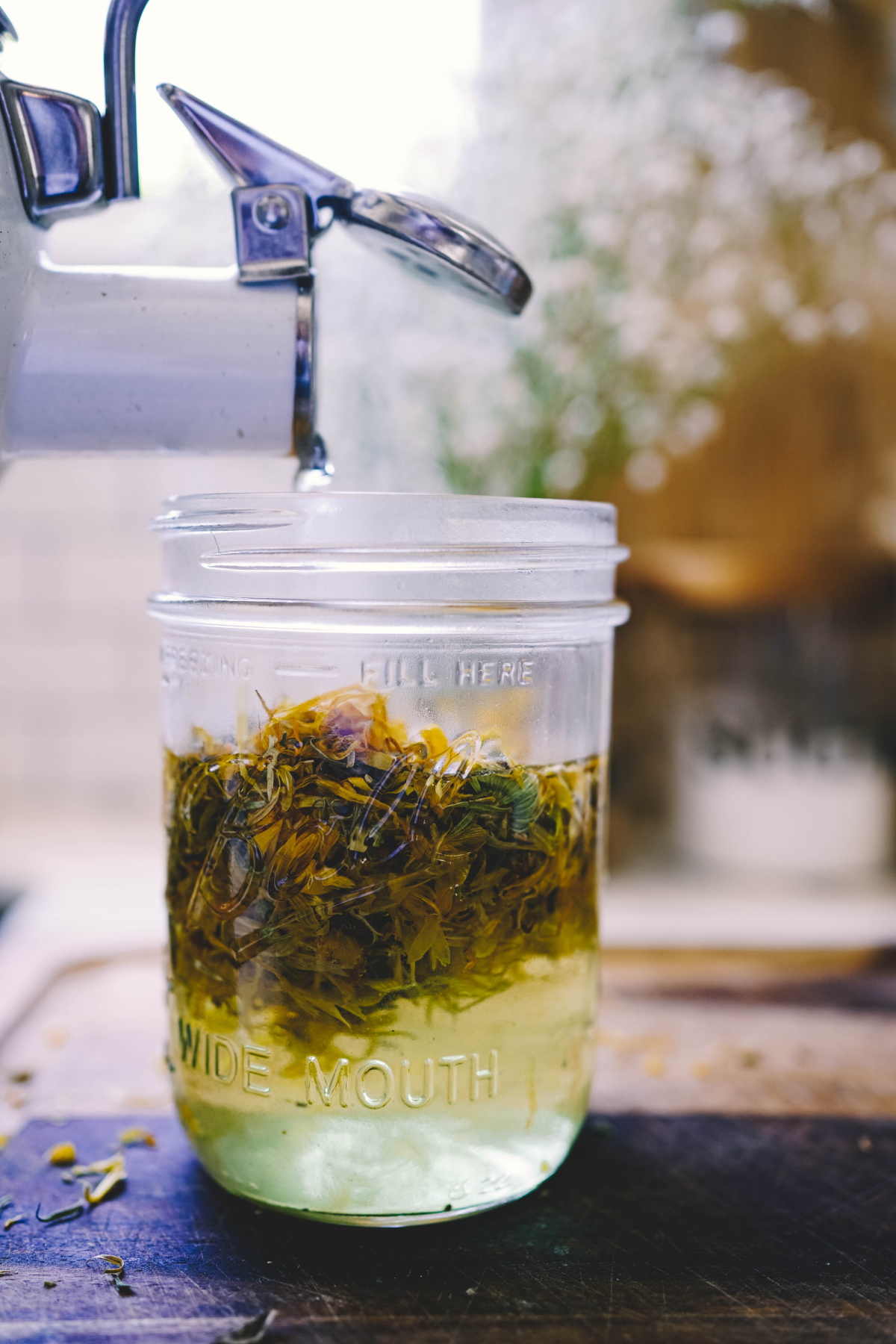
Cool Infusions
Cool infusions, called shita kashaya, are made by infusing delicate herb parts in room temperature water and leaving them to steep for several hours. This is commonly done overnight, keeping the infusion covered at room temperature. Since this type of herbal preparation is cool in nature, it is ideal for pitta dosha. Furthermore, you can put the infusion out under moonlight to steep; from an ayurvedic perspective, this will further enhance the cooling, soothing, and lunar qualities of the infusion (Dass, 2013; Halpern, 2012).
You can make a cool infusion using whole, delicate herb parts, such as hibiscus (Hibiscus sabdariffa) flowers, peppermint (Mentha x piperita) leaves, or rose (Rosa spp.) petals. You can also use powdered herbs for cool infusions. For instance, triphala powder is often administered as a shita kashaya. There are several different ways you can do this. One method is the following:
½ teaspoon triphala powderTriphala Shita Kashaya
This herbal preparation uses boiling water, however, since one takes the preparation at room temperature, it is commonly known as a shita kashya, or cool infusion. For a more warming effect, one could take the triphala infusion hot. If more moisture is called for, a triphala-infused ghee is preferred. Yield: 2 doses.
8-12 fluid ounces boiled water
When To Use:
Triphala shita kashaya is helpful for all-around digestive support and bowel regulation. For a stronger laxative effect, triphala capsules taken with warm water will likely be more effective. However, this is a gentle way of taking triphala that is generally safe for long-term use.
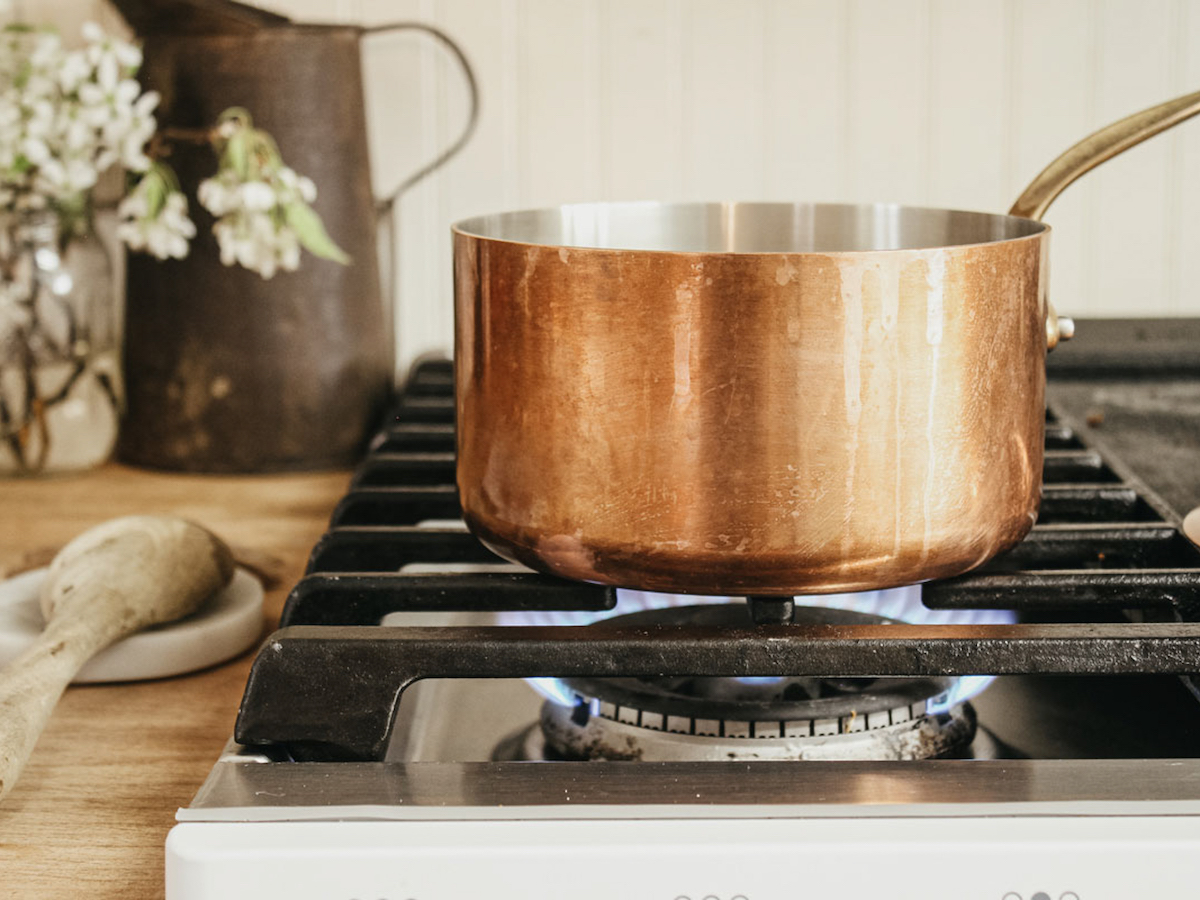
Hot Infusions
Known as phanta, hot infusions are generally more warming in nature. Thus, they are good choices for vata and kapha individuals and for cooler times of the year. However, the chosen herb(s) always plays a role in the energetics of the preparation. Even still, for someone with a pitta imbalance, it would be better for them to take the infusion at room temperature rather than hot, even if cooling herbs are used (Halpern, 2012).
To make a hot herbal infusion, simply steep your chosen whole or powdered herbs in hot water. The quantity of herb and steeping time depends on the herb and the desired strength of the infusion. However, as a general guideline, if using dried herbs, add 1 teaspoon to 1 tablespoon of herb per 8 fluid ounces of water. If using fresh herbs, add one large handful per 8 fluid ounces of water. Or, if you want a more targeted, potent effect, 1 ounce (by weight) of dried herb per 32 fluid ounces of water is ideal (Groves, 2016).
Like cool infusions, the more delicate herb parts like flowers and leaves are better suited for this method. Next, we will discuss decoctions, which are better suited for tough plant parts such as bark and roots, which do not have a chance to adequately break down using the infusion method.
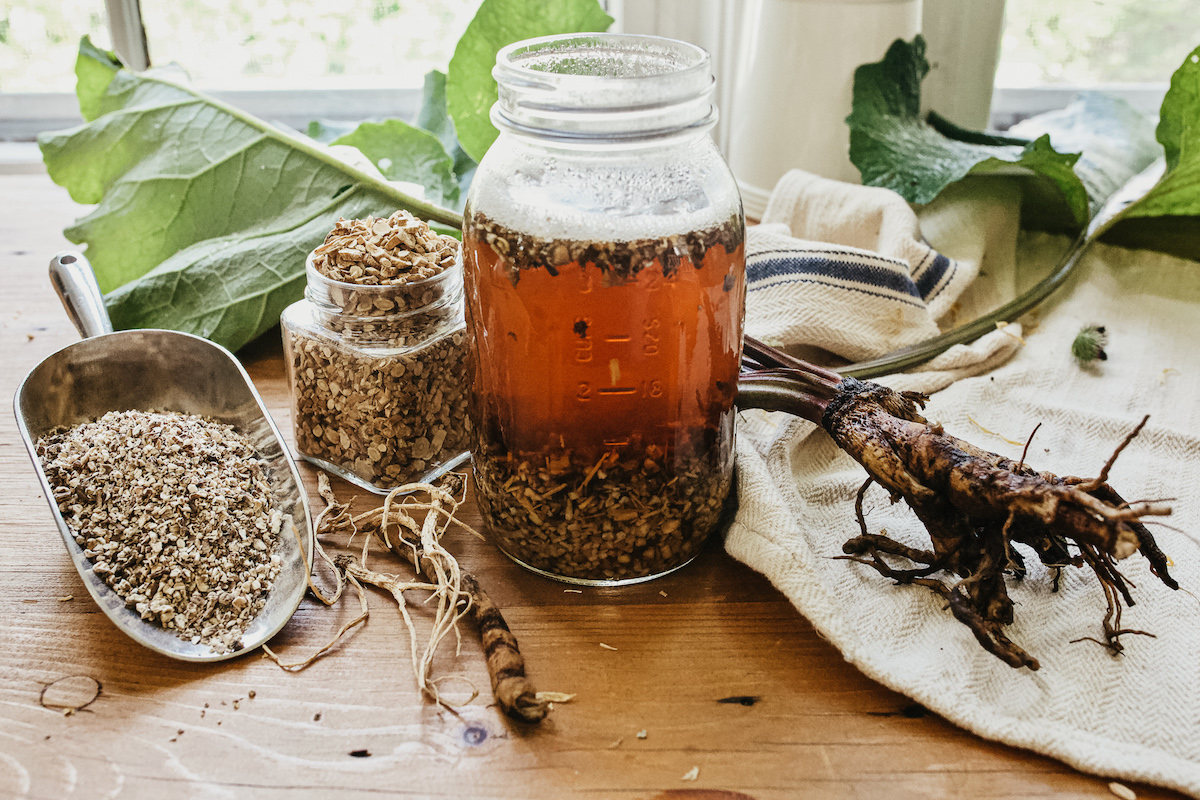
Water and Milk Decoctions
If you are working with tough herb parts, such as the bark or roots, decoction may be a good choice. This can be done using only water or milk and water. The strength of your decoction will depend upon not only the quantity of herbs but also how long you let the decoction simmer. You can make a moderate decoction by simmering off ½ the amount of water you started with. For instance, if you begin with 3 tablespoons of dried herbs and 4 cups (32 fluid ounces) of water, you would leave the decoction on a low boil until 2 cups (16 fluid ounces) of water remain. You can make a stronger decoction by simmering off ¾ of the water you started with (reducing the water from 4 cups to 1). Or, some classical texts even suggest decocting until only ⅛ of the liquid remains (Halpern, 2012). This would be a very potent decoction! If the decoction is very bitter and difficult to swallow, a bit of sugar or honey may be added.
Decoctions may be used in working with any of the three doshas. However, one will want to consider the dosha to determine the strength of the decoction. For instance, vata individuals tend towards a delicate digestion or variable digestive fire and are typically more sensitive to the effects of herbs. Therefore, a milder decoction will likely be better suited to those with a vata constitution or vata imbalance. On the other hand, pitta and kapha types will often respond better to stronger decoctions.
Milk Decoctions
You can make a decoction using only water and herbs, or you can add milk (or plant-based milk) for a more nutritive effect. Milk decoctions, which are heavier and sweeter than plain water decoctions, are typically more suited to working with vata and pitta doshas, as those doshas tend to require tonification more often than kapha types or those with a kapha imbalance. To make a milk decoction, you would start with equal amounts of milk and water and then simmer until the amount of liquid equal to the quantity of water you started with completely evaporates (Halpern, 2012). For instance, if you started with 2 cups of milk and 2 cups of water, you would simmer the mixture until 2 cups of liquid remained.
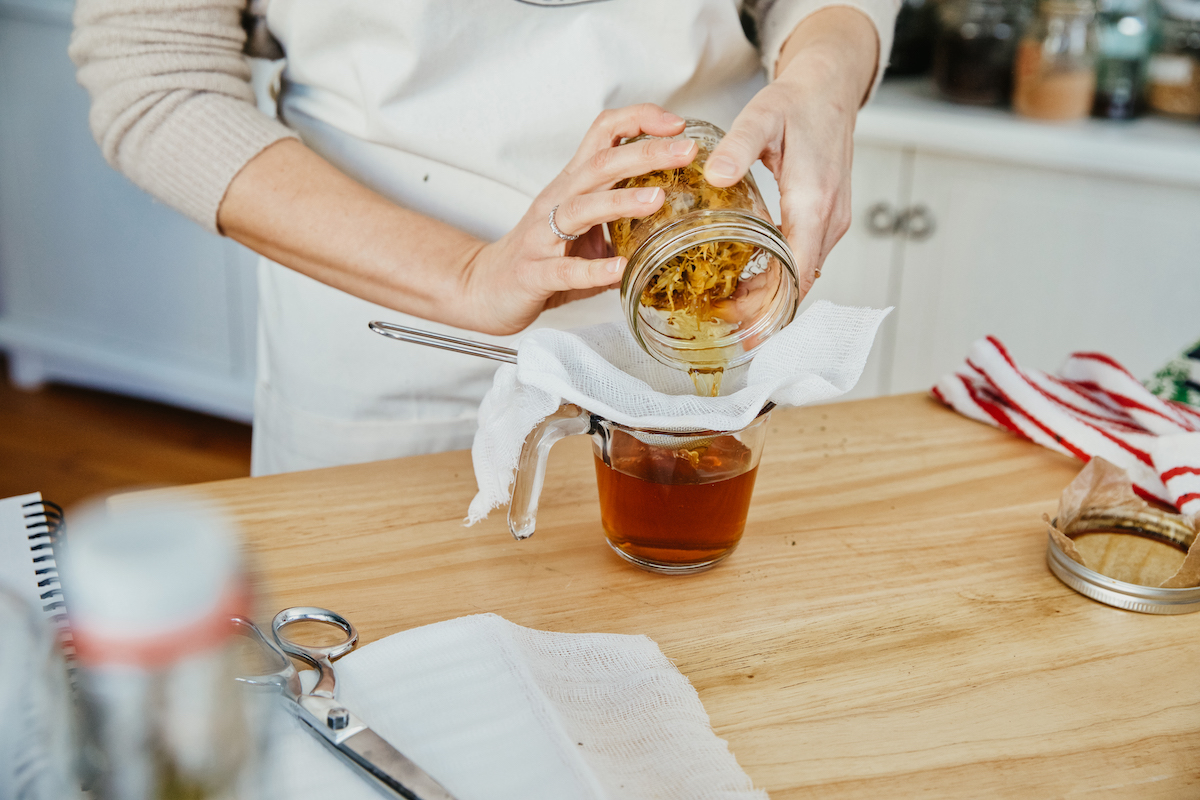
Tincture
The ayurvedic perspective on tinctures is quite interesting. When tinctures are made with alcohol or vinegar, they are considered sour and heating. Though the amount of alcohol or vinegar consumed in each dosage of tincture is relatively small, Ayurveda generally considers alcohol and vinegar tinctures to be best reserved for vata individuals or vata imbalances. The sour taste is heating and balancing for vata dosha (Halpern, 2012). However, it aggravates both pitta and kapha doshas. Glycerin tinctures would be a better choice for pitta dosha.
Another consideration with tinctures is the nutritive effect. From the ayurvedic perspective, taking in the whole herb, as one does when taking powdered herbs, is generally considered more nutritive. When one consumes the whole herb, be it as a capsule or infused in water, milk, or ghee, the consumer imbibes more of the earth element (Halpern, 2012). Therefore, if tonification is the goal, one may be better off taking the herb as a powder. Alternatively, milk decoctions and herbal ghee tend to be more nutritive than tinctures or tea. Ayurveda prefers tinctures for purification. An example of a good use for a tincture in Ayurveda would be to stimulate the digestive fire in a vata individual. The sour taste of the alcohol would augment the stimulating, heating qualities of the formula.
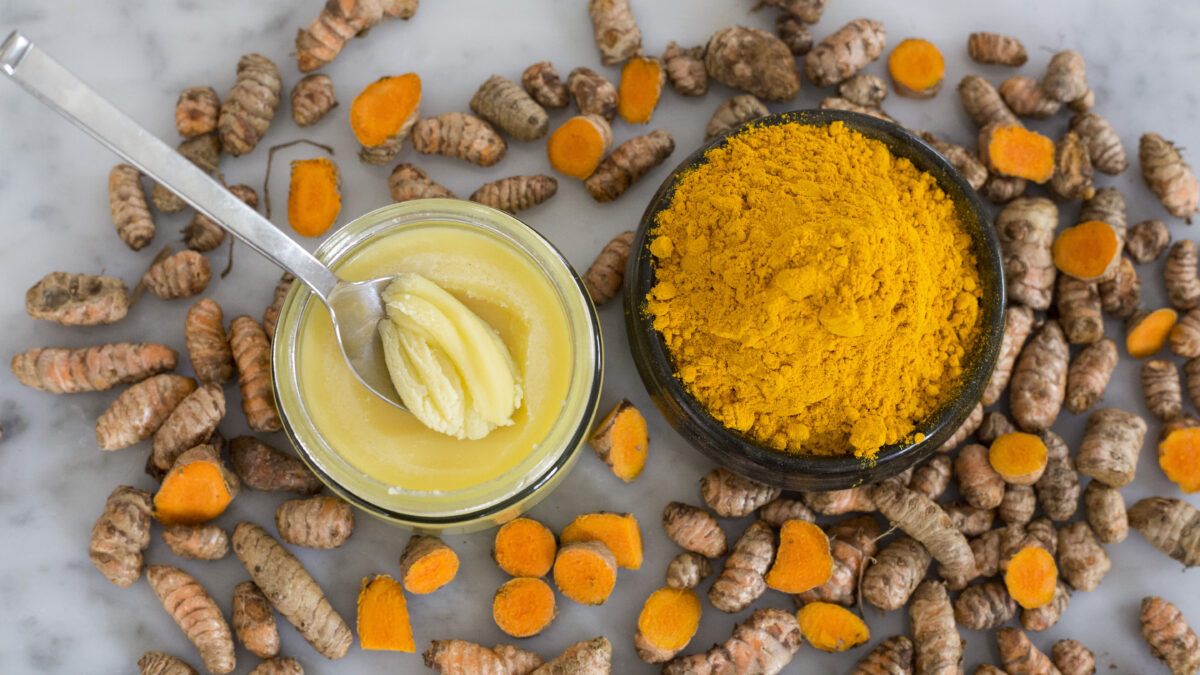
Herbal Ghee
Speaking of nutritive forms of consuming herbs, one can’t talk of ayurvedic herbal preparations without mentioning ghee. Within the ayurvedic tradition, you will discover myriad uses for ghee, both topically and internally. Ayurveda teaches that ghee nourishes ojas (vigor/vitality), gently stokes the digestive fire, and is suitable for all three doshas. In addition, “Ghee also acts as a yogavahi, or catalytic agent that helps to carry the medicinal properties of herbs into the seven dhatus” (Dass, 2013, p. 111). The seven dhatus are the seven tissues of the body. From an ayurvedic perspective, when herbs are infused in ghee, they can reach deeper into the tissues.
There are several different methods of making herbal ghee. I describe the method that I am most familiar with in my Herbal Academy blog post, Ayurvedic Uses of Herbal Oils and Ghee. However, you can also make a simple ghee infusion as you would do with other types of oil infusions.
Since ghee is favorable for all three doshas, herbal ghee can be made for vata, pitta, or kapha issues. However, ghee is generally considered nutritive and tonifying, so herbal ghee is more commonly thought of for vata or pitta-type imbalances. The moist quality of ghee is especially balancing for the dryness associated with vata dosha.
In Closing,
My hope is that this article has widened and deepened your thinking around the best type of herbal preparation for a given person or circumstance. The next time you are struggling to decide whether to take or make a tincture, decoction, tea, or ghee, you now have a bit more knowledge from an ayurvedic perspective to guide your way!
For more on herbal preparations, see:
How To Use the “Folk Method” to Make Herbal Preparations
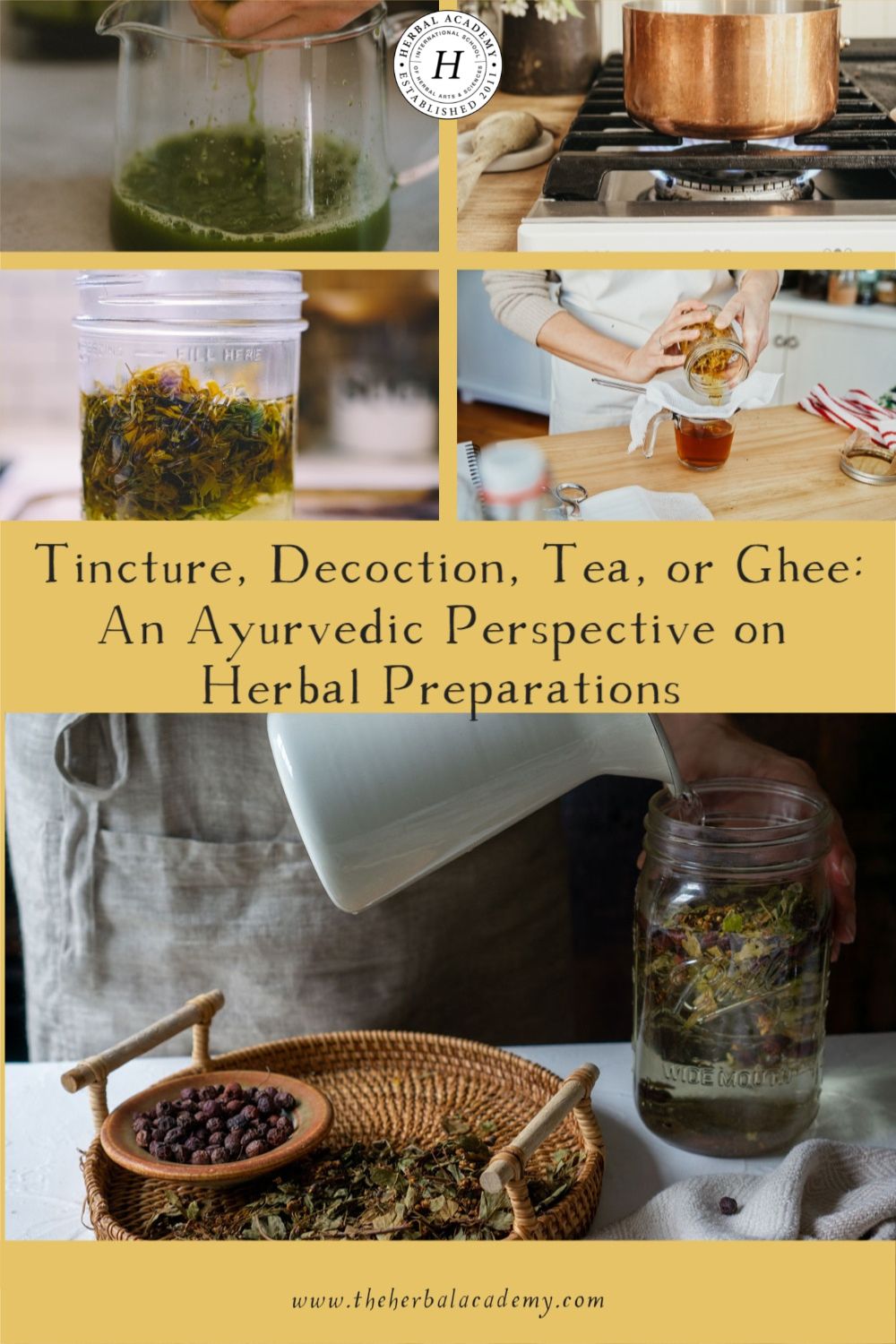
REFERENCES
Dass, V. (2013). Ayurvedic herbology East & West: A practical guide to ayurvedic herbal medicine. Lotus Press.
Groves, M. N. (2016). Body into balance: An herbal guide to holistic self-care. Storey Publishing.
Halpern, M. (2012). Principles of ayurvedic medicine (10th ed.). California College of Ayurveda.







